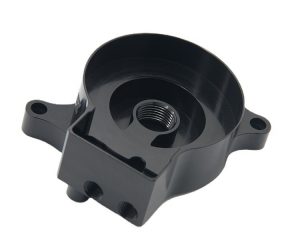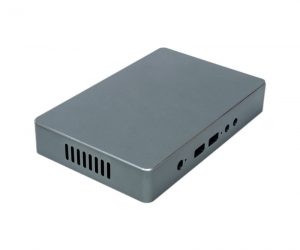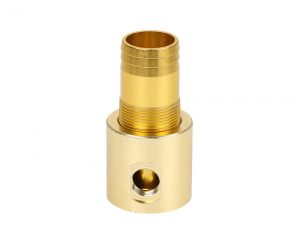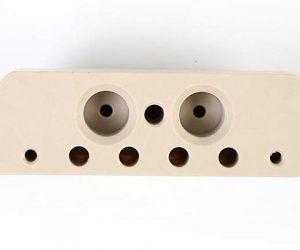1. Introduction: The Core of Modern Manufacturing Precision
In an era where industrial innovation hinges on micrometer - level accuracy, precision CNC machining stands as the backbone of advanced manufacturing. From aerospace components demanding ±0.001mm tolerances to medical implants requiring biocompatible surface finishes, the ability to transform digital designs into physical parts with unmatched precision is non - negotiable.
Take the aerospace industry as an example. Jet engine turbine blades are subjected to extreme temperatures and mechanical stresses. A deviation of even a fraction of a millimeter in their shape can lead to inefficiencies in engine performance, reduced fuel efficiency, and potentially catastrophic failures. Precision CNC machining ensures that these blades are produced with the exact geometry and surface finish required, typically with tolerances in the range of ±0.001 - ±0.01mm.
In the medical field, hip implants, for instance, must fit precisely into the patient's anatomy to ensure proper functionality and long - term success. The surface finish of these implants also plays a crucial role in osseointegration, the process by which the implant fuses with the bone. Precision CNC machining allows for the creation of implants with smooth, biocompatible surfaces and tight dimensional tolerances, usually within ±0.05 - ±0.1mm, depending on the specific requirements.
This article dissects the key drivers behind this technological excellence, exploring how innovation in machinery, materials, and processes propels the industry forward. By leveraging real - world case studies, comparative data, and expert insights, Yigu Technology uncover the mechanisms that ensure precision CNC machining remains the gold standard for complex, high - stakes applications.
2. Technological Foundations: Engineering Precision at the Microscale
2.1. Machine Tool Rigidity and Geometric Accuracy
The foundation of precision lies in the mechanical integrity of CNC machines. Leading manufacturers like Delva Tool & Machine (AS9100D certified) invest in high-rigidity frames constructed from stress-relieved cast iron, reducing thermal and vibrational distortions. Key components such as:
- Spindle Systems: High-speed spindles with ceramic bearings achieve rotational accuracy within 0.1μm, critical for machining aerospace turbine blades with surface finishes of Ra 0.2μm. Ceramic bearings, with their high stiffness and low friction, can withstand high rotational speeds while maintaining minimal run - out. In an aerospace application, a turbine blade needs to be machined with such precision that any deviation in the spindle's rotation could lead to an uneven surface finish, affecting the aerodynamic performance of the blade.
- Linear Guides: Pre-loaded 滚珠丝杠 (ball screws) and hydrostatic rails ensure positioning accuracy of ±0.005mm over 1000mm travel, as seen in Sinbo Precision’s 500+ imported CNC machines. Ball screws, with their high efficiency and precise motion transfer, are widely used in CNC machines. Hydrostatic rails, on the other hand, use a thin film of oil to support the moving parts, providing extremely smooth motion and high damping against vibrations.
A comparative Yigu Technology table highlights the superiority of modern CNC systems over traditional machining:
| Parameter | Traditional Machining | Precision CNC Machining | Improvement |
| Positioning Accuracy | ±0.05mm | ±0.001mm | 98% |
| Surface Finish (Ra) | 1.6μm | 0.4μm | 75% |
| Thermal Stability | ±2°C tolerance | ±0.5°C controlled | 75% |
As shown in the Yigu Technology table, precision CNC machining has made remarkable progress in positioning accuracy, surface finish, and thermal stability compared to traditional machining. The 98% improvement in positioning accuracy means that CNC machines can place the cutting tool with much greater precision, enabling the creation of more complex and accurate parts. The significant improvement in surface finish allows for components that require high - quality finishes, such as those in the optical and medical industries. And the better thermal stability ensures that the machine can operate under a more controlled temperature environment, reducing the risk of thermal expansion - induced errors.
2.2. Advanced Tooling: The Edge of Precision
Cutting tools are the interface between machine and material, and innovations here directly impact accuracy. Diamond-tipped end mills (used for aluminum alloys) achieve edge radii as small as 5μm, enabling micro-features in medical device components. Aluminum alloys are widely used in the medical device industry due to their lightweight and corrosion - resistant properties. The use of diamond - tipped end mills allows for the creation of intricate features, such as the micro - channels in some medical sensors, with high precision.
For hard materials like Inconel 718 (hardness ≥45 HRC), carbide tools with nano - coatings (e.g., AlCrN) extend tool life by 30% while maintaining dimensional stability. Inconel 718 is a nickel - based superalloy known for its high strength and excellent corrosion resistance at high temperatures, making it a popular choice in the aerospace and oil - and - gas industries. The nano - coatings on carbide tools can reduce friction and wear, improving the tool's performance and lifespan.
Yigu Technology Case Study: A medical device manufacturer used cryogenically treated carbide drills to machine 0.5mm - diameter holes in titanium alloy spinal implants, achieving a depth - to - diameter ratio of 20:1 with zero burrs—a feat impossible with conventional tooling. Titanium alloys are commonly used in spinal implants because of their biocompatibility and high strength - to - weight ratio. Cryogenic treatment involves cooling the carbide drills to extremely low temperatures, which can improve their hardness and toughness. This case study demonstrates how advanced tooling can enable the production of high - precision medical components that meet the strict requirements of the medical industry.
3. Material Mastery: Conquering Complexity in Every Alloy
3.1. Machining Exotic Materials
The aerospace and defense industries are at the forefront of demanding materials that push the boundaries of machining capabilities. Titanium alloys, such as Ti - 6Al - 4V, are widely used due to their high strength - to - weight ratio and excellent corrosion resistance. However, their low thermal conductivity (about 7 - 8 W/(m·K), compared to 401 W/(m·K) for copper) means that heat generated during machining is not easily dissipated. This can lead to rapid tool wear and reduced dimensional accuracy. Tungsten carbide, with its extreme hardness (up to 2500 HV) and high melting point, also presents significant challenges, including high adhesion to cutting tools.
To overcome these obstacles, precision CNC shops have developed several innovative strategies. High - pressure coolant systems are a game - changer in machining titanium and other hard - to - machine materials. By delivering coolant at pressures of up to 100 bar, these systems can effectively flush away chips, preventing them from re - cutting and causing damage to the workpiece and tool. Additionally, they can reduce tool temperatures by as much as 200°C. In the machining of aerospace structural brackets made from titanium, high - pressure coolant systems have been shown to improve tool life by 30 - 50% and reduce surface roughness by 20 - 30%.
Vibration damping fixtures are another crucial innovation. Custom - designed fixtures with viscoelastic pads can minimize chatter during machining. Chatter is a self - excited vibration that can occur when the cutting forces interact with the dynamic characteristics of the machine - tool - workpiece system. In the machining of nickel - based superalloys, which are often used in high - temperature applications in aerospace engines, vibration damping fixtures enable thin - wall machining with wall thicknesses as low as 0.8mm or even less. This is essential for reducing the weight of components while maintaining their structural integrity.
3.2. Plastic and Composite Machining
The use of plastics and composites is on the rise in various industries, from aerospace to medical and consumer electronics. Polymers like PEEK (Polyether - ether - ketone) are highly valued in the medical field for their biocompatibility, high strength, and chemical resistance. Carbon - fiber - reinforced plastics (CFRP) are widely used in aerospace for their excellent strength - to - weight ratio. However, machining these materials requires a different set of techniques to minimize heat - induced deformation.
Air - cooled spindles running at high speeds, such as 100,000 RPM, are a common solution in machining plastics and composites. The high - speed rotation allows for faster material removal rates, reducing the heat generated per unit volume of material removed. In addition, the use of positive rake angle tools can help to reduce the cutting forces and heat generation. Sinbo Precision, a leading player in precision machining, has achieved remarkable results in machining CFRP. By using air - cooled spindles and positive rake angle tools, they have been able to keep the delamination rates below 0.5%, well within the aerospace standards for structural components. Delamination is a major concern in CFRP machining, as it can significantly reduce the mechanical properties of the material.
The Yigu Technology table below summarizes the key challenges and solutions in machining different materials:
| Material Type | Key Challenges | Solutions |
| Titanium Alloys | Low thermal conductivity, high adhesion, high strength | High - pressure coolant systems, vibration damping fixtures |
| Tungsten Carbide | Extreme hardness, high melting point, high adhesion | Specialized cutting tools, high - pressure coolant systems |
| PEEK and Other Polymers | Heat - induced deformation | Air - cooled spindles, positive rake angle tools |
| CFRP | Delamination, heat - induced deformation | Air - cooled spindles, positive rake angle tools, optimized cutting parameters |
As shown in the Yigu Technology table, each material type has its unique challenges, and the solutions are tailored to address these specific issues. The use of high - pressure coolant systems and vibration damping fixtures for metals, and air - cooled spindles and positive rake angle tools for plastics and composites, highlights the importance of material - specific machining strategies in precision CNC machining.
4. Case Studies: Precision in Action
4.1. Aerospace Engine Component Machining
A leading aerospace OEM faced the challenge of producing a Ti - 6Al - 4V compressor blade with extremely tight tolerances. The required chordal tolerance was 0.01mm, and the surface finish had to be 0.3μm. These specifications were not just about meeting the design requirements but also about ensuring the long - term performance and safety of the engine. A deviation in the chordal dimension could lead to aerodynamic inefficiencies, resulting in reduced engine thrust and increased fuel consumption. The surface finish was crucial for preventing fatigue failures, as rough surfaces could act as stress concentrators, leading to cracks and potential engine failures.
To achieve these exacting standards, a combination of 5 - axis CNC machining and ultrasonic vibration assistance was employed. The 5 - axis machining allowed for complex geometries to be machined in a single setup, reducing the need for multiple operations and potential errors. The ultrasonic vibration assistance, on the other hand, had a profound impact on the cutting process. By applying high - frequency vibrations to the cutting tool, the cutting forces were reduced by 30%. This reduction in cutting forces was critical in eliminating stress - induced deformation, which was a major concern in machining such a high - strength alloy. The reduced cutting forces also meant that the tool life was extended, as there was less wear and tear on the cutting edges.
The project's success was not just measured by meeting the dimensional and surface finish requirements. It also had to meet NASA’s stringent fatigue requirements. Fatigue is a major failure mode in aerospace components, and the compressor blades are subjected to cyclic loading during engine operation. The combination of 5 - axis machining and ultrasonic vibration assistance ensured that the internal stresses in the blade were minimized, and the surface integrity was optimized. This, in turn, enabled the blade to withstand the cyclic loading over its expected service life, meeting NASA's fatigue requirements.
4.2. Medical Implant Prototyping
Sinbo Precision took on the challenge of machining a patient - specific cranial implant from PEEK. The process started with the collection of MRI scans of the patient's skull. These scans were then used to generate CAD data, which served as the blueprint for the implant. The complexity of the human skull and the need for a perfect fit made this a challenging task. The implant had to match the patient's unique cranial anatomy precisely to ensure proper function and osseointegration, the process by which the implant fuses with the bone.
The machining process involved 0.05mm layer - by - layer milling with adaptive toolpath optimization. The layer - by - layer milling allowed for the creation of complex geometries with high precision. The adaptive toolpath optimization, on the other hand, adjusted the toolpath in real - time based on the material properties and the machining conditions. This ensured that the cutting forces were evenly distributed, reducing the risk of tool breakage and improving the surface finish.
The result was a fit accuracy of ±0.07mm, which was critical for the success of the implant. A deviation of more than this could lead to poor osseointegration, which could cause the implant to loosen or fail over time. The precise fit also ensured that the implant provided the necessary support to the skull, protecting the brain and promoting normal function. The use of PEEK, a biocompatible polymer, further enhanced the implant's performance, as it was well - tolerated by the body and had excellent mechanical properties.
FAQ: Common Questions About Precision CNC Machining
Q1: How do I ensure my design is compatible with precision CNC machining?
Work with your manufacturer early to review design for manufacturability (DFM). Key considerations include feature size (minimum diameter ≥0.3mm for drilling), wall thickness (≥0.5mm for most metals), and tolerance consistency. Advanced CAM software can simulate machining feasibility and suggest design adjustments. For example, if you're designing a part with very thin walls, the CAM software can analyze the stress distribution during machining and recommend modifications to prevent deformation. By collaborating closely with the manufacturer and leveraging CAM technology, you can significantly increase the likelihood of a successful machining process.
Q2: What’s the difference between “precision” and “accuracy” in CNC machining?
- Precision: Refers to repeatability (e.g., producing 100 parts within ±0.001mm of each other). It focuses on how closely the measurements of multiple parts are to each other. High - precision machining means that the parts produced are very consistent in their dimensions, regardless of how close they are to the target design.
- Accuracy: Refers to how close parts are to the nominal design (e.g., average deviation from target ≤0.002mm). It measures the deviation of the actual part dimensions from the intended design specifications. A high - accuracy machining process ensures that the parts produced match the design as closely as possible.
Both are critical; look for suppliers Yigu Technology with CMM data demonstrating high Cpk values for both metrics. Cpk is a statistical measure that indicates how well a process is performing within the specified tolerance limits. A high Cpk value for precision means that the process is highly repeatable, and a high Cpk value for accuracy means that the process is producing parts very close to the target design.
Q3: Can precision CNC machining handle low - volume production cost - effectively?
Yes. While setup costs for complex programs are higher, modern CNC machines excel at rapid changeovers (≤1 hour for tooling and fixtures). For batches of 1–100 parts, precision CNC often offers better surface finish and tighter tolerances than 3D printing, making it ideal for prototypes and low - run critical components. For instance, in the production of high - end medical device prototypes, where a small number of parts are needed but with extremely tight tolerances and high - quality surface finishes, precision CNC machining can provide the necessary quality at a reasonable cost. The ability to quickly change over tooling and fixtures allows for efficient production even in low - volume scenarios, making it a viable option for many applications.





